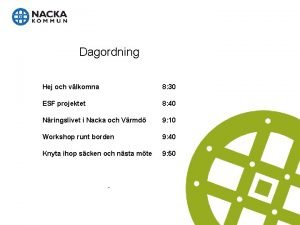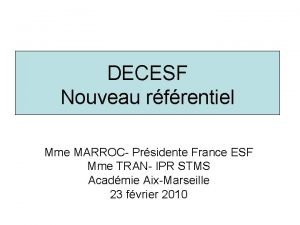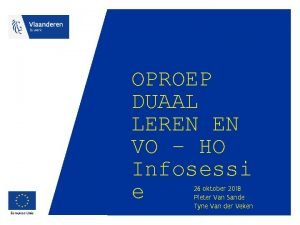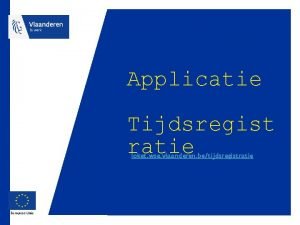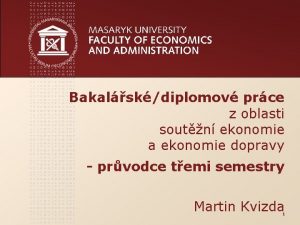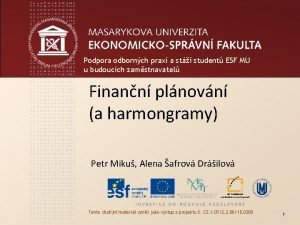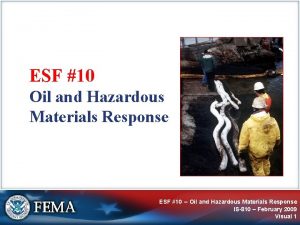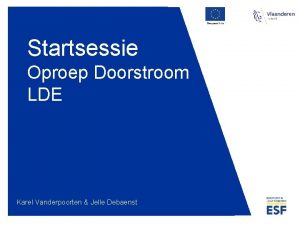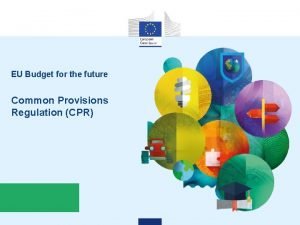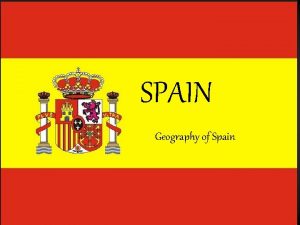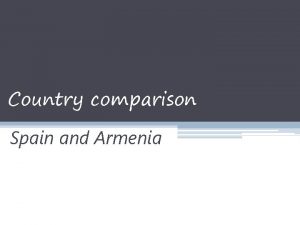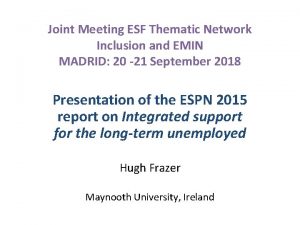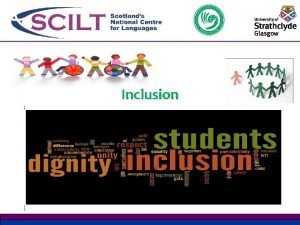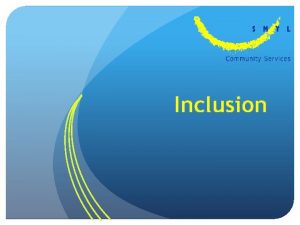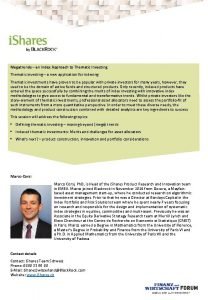Active Inclusion in ESF SPAIN ESF Inclusion Thematic

















- Slides: 17

Active Inclusion in ESF SPAIN ESF Inclusion Thematic Network and EMIN 20 th & 21 st September Madrid

2014 -2020 Structural Funds allocation for SPAIN ESF +Youth Employment Initiative (YEI) 9. 096 billion euros. + Fund for European Aid to the Most Deprived (FEAD) • ESF: 7, 589 billion euros • YEI: 943, 5 million euros • FEAD: 563, 4 million euros

ESF Allocation by category of REGIONS • More developed: 12 regions (Galicia and Asturias at 80% and the rest at 50% and Ceuta at 80%). Total ESF = 3. 323. 594. 255 • Transition: 4 regions ( Andalucía, Murcia, Castilla-La Mancha and Melilla at 80% and Canarias at 85%). Total ESF = 3. 710. 223. 477 • Less developed: Extremadura 80%. Total ESF = 555. 751. 405 33

Distribution by Thematic Objectives The ESF operates in Spain in 3 Thematic Objectives: Employment, Social Inclusion, Education and Vocational Training. • TO 8. “To promote sustainibility and quality of employment and Foster labour mobility”: 3. 595. 172. 476 € ESF + 943. 496. 315 € YEI • TO 9. “To promote social inclusion, fight against poverty and all forms of discrimination”: 1. 944. 742. 719 € ( 23 % of total ESF budget) • TO 10. “Invest in education, training and vocational training for the adquisition of skills and lifelong learning”: 1. 879. 757. 967 € + Technical Assistance: 169. 895. 975 €

2014 -2020 ESF Operational Programmes 23 ESF Operational Programmes are being implemented in SPAIN + FEAD National Operational Programmes: - O. P. Employment, Training and Education. - O. P. for Social Inclusion and Social Economy. - O. P. for Youth Employment. - O. P for Technical Assistance. Regional Operational Programmes: - 19 O. Ps: One per Autonomous Community or City. 5 5

Financial Allocation by ESF Programmes The programme with a bigger allocation in terms of ESF assistance is the Youth Employment O. P. with 2, 361 billion Euros. Both the national and regional Public Administration participate in it. Operational Programmes ESF Assistance Youth Employment 2. 360. 617. 818 Employment, Training and Education 2. 115. 030. 502 Social Inclusion and Social Economy 800. 050. 000 Technical Assistance Regional O. Ps. (19) 35. 000 3. 222. 367. 134 6 6

HOW MUCH for Social Inclusion? The 20 % minimum investment requirement for social inclusion is 50 % shared between the national and regional level implementation. (Article 4(2) of Regulation (EU) No 1304/2013 ) Up to 23% of total ESF Budget for Social Inclusion • National Programmes -mainly through Social Inclusion and Social Economy O. P and Employment Training and Education O. P • Regional Programmes - all regional O. Ps allocate at least 20 % of their Budget.

HOW ? Social Inclusion and Social Economy O. P (POISES) ØReinforcing the social inclusion of disadvantaged people with a view to their sustainable integration in employment and combating all forms of discrimination in the labour market. ØMain features: • Integrated approach: targeting at people and structures of the labour market; • Focusing on the most disadvantaged target groups at risk of social exclusion; • Complies with the mínimum investment of 20% of the ESF in T. O. 9 (Social Inclusion) required by Regulations (National level); • Aligned with partnership principle, combining management between public & private institutions ( civil sector NGO’s) • Integrated strategy, in coordination with other ESF Operational Programmes. 8

HOW? Social Inclusion and Social Economy OP (POISES) • Thematic Objectives : 8 and 9 • Investment Priorities: – – – • 8. 3. Self employment and entrepreneurship; 8. 4 Equal opportunities between men and women; 9. 1. Active inclusión (Integrated pathways); 9. 2. Integration of marginalised communities (Roma people); 9. 3. Fighting against discrimination and equal opportunities; 9. 5. Fostering entrepreneurship and social economy Financial allocation : 800. 050. 000 €

Social Inclusion and Social Economy OP Priority Axis allocation Axis 1: promoting sustainable and quality employment and supporting labour mobility. 29. 602. 047€ 3. 7% Axis 2 : promoting social inclusion, combating poverty and any discrimination 736. 707. 183€ 92. 1% Axis 6: Social Innovation 8. 197. 658€ 1% Axis 7: Transnational Cooperation 5. 541. 862€ 0. 7% Axis 8: Technical Assistance 20. 001. 250 € 2, 5%

HOW? Social Inclusion and Social Economy OP (POISES) T. O 9 measures: • Promotion of and support to entrepreneurship and self employment in the field of social economy. • Support to internationalisation and innovation in social enterprises. • Development of integrated individualised pathways for social and labour integration of most disadvantaged target groups, such as disabled people. • Measures aimed at persons belonging to marginalised communities, particularly, roma people. • Initiatives aimed at promoting profesional diversification of women.

Social Inclusion and Social Economy OP (POISES) How is FINANTIAL implementation progressing? FINANTIAL IMPLEMENTATION JULY 2018 • public eligible cost of selected operations Total amount % 696. 401. 048, 38 € 87, 04 • eligible expenditure declared to M. A 112. 684. 747, 97 € 14, 08 • forecast payment applications to be submitted in 2018 376. 034. 335, 08 € 47, 00

Social Inclusion and Social Economy OP (POISES) How is PHYSICAL implementation progressing? 400. 821 participants in ESF actions ( 81, 87 % at risk of social inclusion ) Source: Annual Implementation Report 2017 implementation year

¿How are stakeholders involved? • Partnership principle by involving both 8 public administrations and civil sector ( 9 NGO’s) in O. P implementation • Target population has been involved in the programming of the O. P by means of public consultation process and bilateral meetings of civil sector organizations which largely represent the most vulnerable. • Call for Project Proposals. 9 NGO’s are carrying out ESF actions targeted mainly to disadvantaged groups.

Transnational Project : Euroma Overall objective: increasing the impact and effectiveness of Structural Funds for Roma Inclusion, notably within ESF and ERDF but also within other European funds and instruments by means of contributing to the relevant policies as regards to ESIF and Roma Inclusion. Total Budget: 625. 623, 87 € Implemented from April 2017 until 31 st October 2019 Members: representatives of the social inclusion policies and Managing Autohorities of the ESIF in 15 Member States.

Euroma Network 2014 -2020 Intervention Logic : • Mutual learning and transfer of knowledge/experiences, both within Management Committee meetings and thematic initiatives (thematic seminars, visits of professionals/participants, peer reviews…), • Generation of knowledge on ESI Funds and Roma inclusion with a view to sharing partners’ experience and common approaches and put forward proposals and recommendations, • Dissemination of the Network and its activities, through the EURoma website https: //www. euromanet. eu/ , the regular newsletters and the participation in relevant spaces and initiatives at EU level.

Thanks for your attention ! Mr. Tuñón Sastre, Lazaro ESF Managing Authority SPAIN Phone: 34 + 913 631 977 lazaro. tunon@mitramiss. es
 Statement of theme example
Statement of theme example Active high and active low
Active high and active low Primary vs secondary active transport
Primary vs secondary active transport Primary active transport vs secondary active transport
Primary active transport vs secondary active transport Esf 4
Esf 4 France esf
France esf Esf applicatie
Esf applicatie Esf 7
Esf 7 Platos tijdregistratie esf
Platos tijdregistratie esf Esf muni harmonogram
Esf muni harmonogram Esf emmen
Esf emmen Esf-2
Esf-2 Fsae esf
Fsae esf Pert diagram
Pert diagram Esf 10
Esf 10 Karel vanderpoorten
Karel vanderpoorten Esf futures
Esf futures Common provisions regulation
Common provisions regulation




